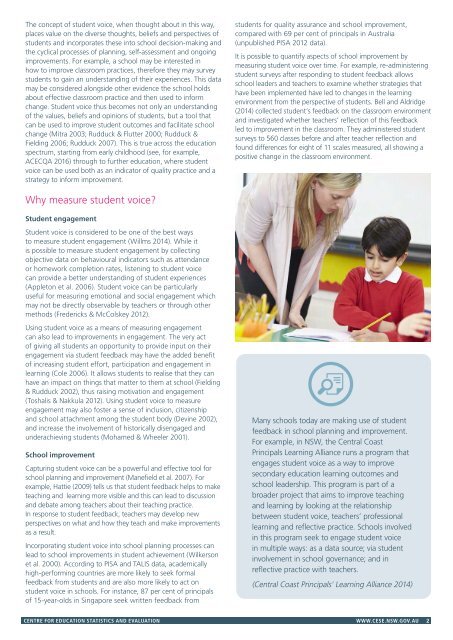Capturing and Measuring Student Voice
Capturing_and_Measuring_Student_Voice_LC_v12
Capturing_and_Measuring_Student_Voice_LC_v12
You also want an ePaper? Increase the reach of your titles
YUMPU automatically turns print PDFs into web optimized ePapers that Google loves.
The concept of student voice, when thought about in this way,<br />
places value on the diverse thoughts, beliefs <strong>and</strong> perspectives of<br />
students <strong>and</strong> incorporates these into school decision-making <strong>and</strong><br />
the cyclical processes of planning, self-assessment <strong>and</strong> ongoing<br />
improvements. For example, a school may be interested in<br />
how to improve classroom practices, therefore they may survey<br />
students to gain an underst<strong>and</strong>ing of their experiences. This data<br />
may be considered alongside other evidence the school holds<br />
about effective classroom practice <strong>and</strong> then used to inform<br />
change. <strong>Student</strong> voice thus becomes not only an underst<strong>and</strong>ing<br />
of the values, beliefs <strong>and</strong> opinions of students, but a tool that<br />
can be used to improve student outcomes <strong>and</strong> facilitate school<br />
change (Mitra 2003; Rudduck & Flutter 2000; Rudduck &<br />
Fielding 2006; Rudduck 2007). This is true across the education<br />
spectrum, starting from early childhood (see, for example,<br />
ACECQA 2016) through to further education, where student<br />
voice can be used both as an indicator of quality practice <strong>and</strong> a<br />
strategy to inform improvement.<br />
students for quality assurance <strong>and</strong> school improvement,<br />
compared with 69 per cent of principals in Australia<br />
(unpublished PISA 2012 data).<br />
It is possible to quantify aspects of school improvement by<br />
measuring student voice over time. For example, re-administering<br />
student surveys after responding to student feedback allows<br />
school leaders <strong>and</strong> teachers to examine whether strategies that<br />
have been implemented have led to changes in the learning<br />
environment from the perspective of students. Bell <strong>and</strong> Aldridge<br />
(2014) collected student’s feedback on the classroom environment<br />
<strong>and</strong> investigated whether teachers’ reflection of this feedback<br />
led to improvement in the classroom. They administered student<br />
surveys to 560 classes before <strong>and</strong> after teacher reflection <strong>and</strong><br />
found differences for eight of 11 scales measured, all showing a<br />
positive change in the classroom environment.<br />
Why measure student voice?<br />
<strong>Student</strong> engagement<br />
<strong>Student</strong> voice is considered to be one of the best ways<br />
to measure student engagement (Willms 2014). While it<br />
is possible to measure student engagement by collecting<br />
objective data on behavioural indicators such as attendance<br />
or homework completion rates, listening to student voice<br />
can provide a better underst<strong>and</strong>ing of student experiences<br />
(Appleton et al. 2006). <strong>Student</strong> voice can be particularly<br />
useful for measuring emotional <strong>and</strong> social engagement which<br />
may not be directly observable by teachers or through other<br />
methods (Fredericks & McColskey 2012).<br />
Using student voice as a means of measuring engagement<br />
can also lead to improvements in engagement. The very act<br />
of giving all students an opportunity to provide input on their<br />
engagement via student feedback may have the added benefit<br />
of increasing student effort, participation <strong>and</strong> engagement in<br />
learning (Cole 2006). It allows students to realise that they can<br />
have an impact on things that matter to them at school (Fielding<br />
& Rudduck 2002), thus raising motivation <strong>and</strong> engagement<br />
(Toshalis & Nakkula 2012). Using student voice to measure<br />
engagement may also foster a sense of inclusion, citizenship<br />
<strong>and</strong> school attachment among the student body (Devine 2002),<br />
<strong>and</strong> increase the involvement of historically disengaged <strong>and</strong><br />
underachieving students (Mohamed & Wheeler 2001).<br />
School improvement<br />
<strong>Capturing</strong> student voice can be a powerful <strong>and</strong> effective tool for<br />
school planning <strong>and</strong> improvement (Manefield et al. 2007). For<br />
example, Hattie (2009) tells us that student feedback helps to make<br />
teaching <strong>and</strong> learning more visible <strong>and</strong> this can lead to discussion<br />
<strong>and</strong> debate among teachers about their teaching practice.<br />
In response to student feedback, teachers may develop new<br />
perspectives on what <strong>and</strong> how they teach <strong>and</strong> make improvements<br />
as a result.<br />
Incorporating student voice into school planning processes can<br />
lead to school improvements in student achievement (Wilkerson<br />
et al. 2000). According to PISA <strong>and</strong> TALIS data, academically<br />
high-performing countries are more likely to seek formal<br />
feedback from students <strong>and</strong> are also more likely to act on<br />
student voice in schools. For instance, 87 per cent of principals<br />
of 15-year-olds in Singapore seek written feedback from<br />
Many schools today are making use of student<br />
feedback in school planning <strong>and</strong> improvement.<br />
For example, in NSW, the Central Coast<br />
Principals Learning Alliance runs a program that<br />
engages student voice as a way to improve<br />
secondary education learning outcomes <strong>and</strong><br />
school leadership. This program is part of a<br />
broader project that aims to improve teaching<br />
<strong>and</strong> learning by looking at the relationship<br />
between student voice, teachers’ professional<br />
learning <strong>and</strong> reflective practice. Schools involved<br />
in this program seek to engage student voice<br />
in multiple ways: as a data source; via student<br />
involvement in school governance; <strong>and</strong> in<br />
reflective practice with teachers.<br />
(Central Coast Principals’ Learning Alliance 2014)<br />
CENTRE FOR EDUCATION STATISTICS AND EVALUATION WWW.CESE.NSW.GOV.AU 2


